








By Al Brown Assignment Editor
The Minnesota SpokesmanRecorder (MSR), a cornerstone of the Twin Cities Black community for nearly a century, has once again demonstrated its commitment to impactful journalism. At the prestigious National Newspaper Publishers Association (NNPA) Messenger Awards 2024, held in Baltimore, the MSR proudly claimed first place in the Faith & Religion category.
This accolade, awarded for Associate Editor Abdi Mohamed’s insightful article on the spiritually based non-profit ARAHA, stands as a powerful testament to the
dedication to showcasing the stories that matter most to its readership and the collective

By Tony Kiene Staff Writer
“My goal with this album is to reintroduce funk music. Give it the respect that it deserves. Get the world to reconnect,” noted André Cymone in describing his latest project, “The Resurrection of Funk.”
“That was the foundation of what we did with Grand Central,” he continued. “And from a Minneapolis standpoint, as we came of age, we had a lot to do with funk in the eighties, putting our own stamp on it. But it seems that music is slipping away from people’s consciousness. I want to go back


to that energy, those sensibilities, that attitude. The spirit of funk, so to speak.”
Cymone, who celebrates his 66th birthday on this week’s MSR publication date (June 27), is one of the most seminal figures in shaping what history has come to know as the Minneapolis Sound. While he’s eternally humble and gracious, it’s likely not lost on Cymone that he doesn’t always get his due.
“André was every bit as talented as Prince,” says Pepé Willie, who worked closely with Grand Central, the band Cymone and Prince played in together as teens. “They both played all the instruments.
Even at that age. Whatever one of them could do, so could the other. It was unbelievable.”
Cymone’s contribution runs much deeper than talent alone; he helped put the whole Minneapolis Sound thing together from the very start.
For André Simon Anderson, the youngest of six children born to Fred and Bernadette Anderson, it didn’t take long to get a sense of what he might want out of life. “My dad was a musician, and he had this upright bass around the house, which I learned to play by the time I was seven or eight.”
Although music came naturally to Cymone, he wasn’t ■ See ANDRÉ CYMONE on page 5


An Olympic-sized pool will provide competitive opportunities for inner-city
By Cole Miska Contributing Writer
The V3 Sports Center, a state-of-the-art pool and sporting complex in North Minneapolis, held its grand opening ceremony on Saturday, June 6. The facility had been running limited hours for the past month and is now open daily. Despite rainy
weather, hundreds of community members attended the ceremony, which included a dance party, fitness demos, food trucks, and activities for kids.
The facility currently includes a 25-yard pool, a fitness center, and a childcare center, with a restaurant opening soon. Director of Facilities Luke Day says that
the grand vision for the facility goes much further—when phase two of the building is complete, it will also host four basketball courts, a 300-meter indoor track, additional banquet space for events, and an Olympic-sized pool. The pool, shipped from Omaha, where U.S. athletes used it to train for the Olympics in 2021, will
By League of Women Voters
s Minnesotans, we understand that exercising our right to vote is fundamental to a healthy democracy. In the 2020 National election, MN was #1 in turnout, with just under 80% of eligible voters casting their ballots. Let’s look at key features of Minnesota voting laws that help increase our citizens’ trust and participation.
Accessibility Minnesota historically has
to
renew your driver’s license or interact with other state agencies like MNCare or Human Services. Voter security is part of voter registration regardless of the method used. To register online, you must provide your address, driver’s license number, State ID information card number, or the last four digits of your social security number.
This information is sent to election officials to create a new voter record or update your registration. All data is
verified using state and federal databases. If you do not have these identification numbers, you can still register to vote using the paper form—election officials will still verify your voting eligibility. You can vote by mail using an absentee ballot. Absentee ballots are only available to MN voters who complete and return an application to their local election official. Your eligibility is confirmed using state and federal databases to verify information
■ See VOTING
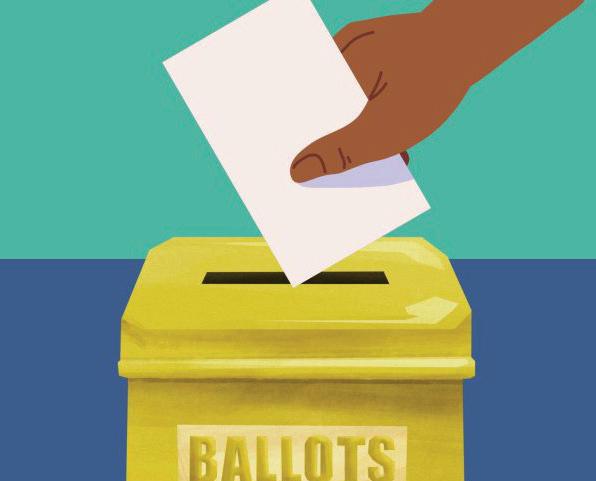
By Al Brown Assignment Editor
On June 19, 2024, the spirited crossroads of Lake Street and Minnehaha Avenue in Minneapolis transformed into a vibrant rainbow of culture, music, food and art as the Soul of the Southside Juneteenth Festival unfolded under clear, sunny skies. This year’s festival, an annual homage to the historic Juneteenth announcement, brought together locals and visitors in a joyous celebration of freedom, unity, and community resilience.
Together, the Soul of the Southside Juneteenth Festival and the Rondo Avenue Juneteenth Celebration exemplified the diverse and dynamic spirit of the Twin Cities.
The festival’s atmosphere was electrifying from the start with the soulful sounds of James Brown and Chic’s “Good Times” filling the air, courtesy of KFAI-FM. The infectious rhythms and uplifting melodies created a magnetic pull, gathering people from all corners to dance, sing, and revel in the day’s significance.
This auditory backdrop set a perfect tone for the commemoration of June 19, 1865, when Union soldiers arrived in Galveston, Texas, to announce freedom for enslaved African Americans more than two years after the Emancipation Proclamation had been signed by President Abraham Lincoln.
The streets around Lake and Minnehaha bustled with activity as festival-goers explored an eclectic mix of taverns, eateries, and local bookstores that seamlessly integrated into the celebration. Moon Palace Books, a staple of the community, saw a surge in interest for Africentric literature. Titles by James Baldwin were particularly in demand, reflecting a burgeoning desire to connect with African American history and literature on a deeper level.
Food vendors lined the streets, their stalls exuding mouth-watering aromas that

hinted at the diverse culinary delights awaiting hungry attendees. From savory BBQ to sweet treats, the food offerings were as varied as they were delicious, providing a taste of the rich cultural heritage being celebrated. Amidst the culinary delights, ice-cold beverages provided a refreshing respite from the warmth of the summer day, keeping spirits high and energies vibrant.
Art played a central role in the festival, with countless artists showcasing their talents. Paintings and drawings adorned pop-up galleries, each piece telling its own story of heritage, struggle and triumph. Community organizations such as the Open Road Fund were on hand, adding to a sense of unity and shared purpose among attendees.
Among the throngs of visitors, smiles and laughter were ubiquitous, bridging generational gaps as young children danced alongside elders and families came together to reflect on their shared history and look forward to a promising future.
The festival wasn’t just a celebration; it was a space for healing and hope, a testament to the enduring spirit of the African American community.
Rondo Avenue celebrates Juneteenth
Meanwhile, in St. Paul the Twin Cities’ festivities also shone brightly with the Rondo Avenue Juneteenth Celebration, aptly





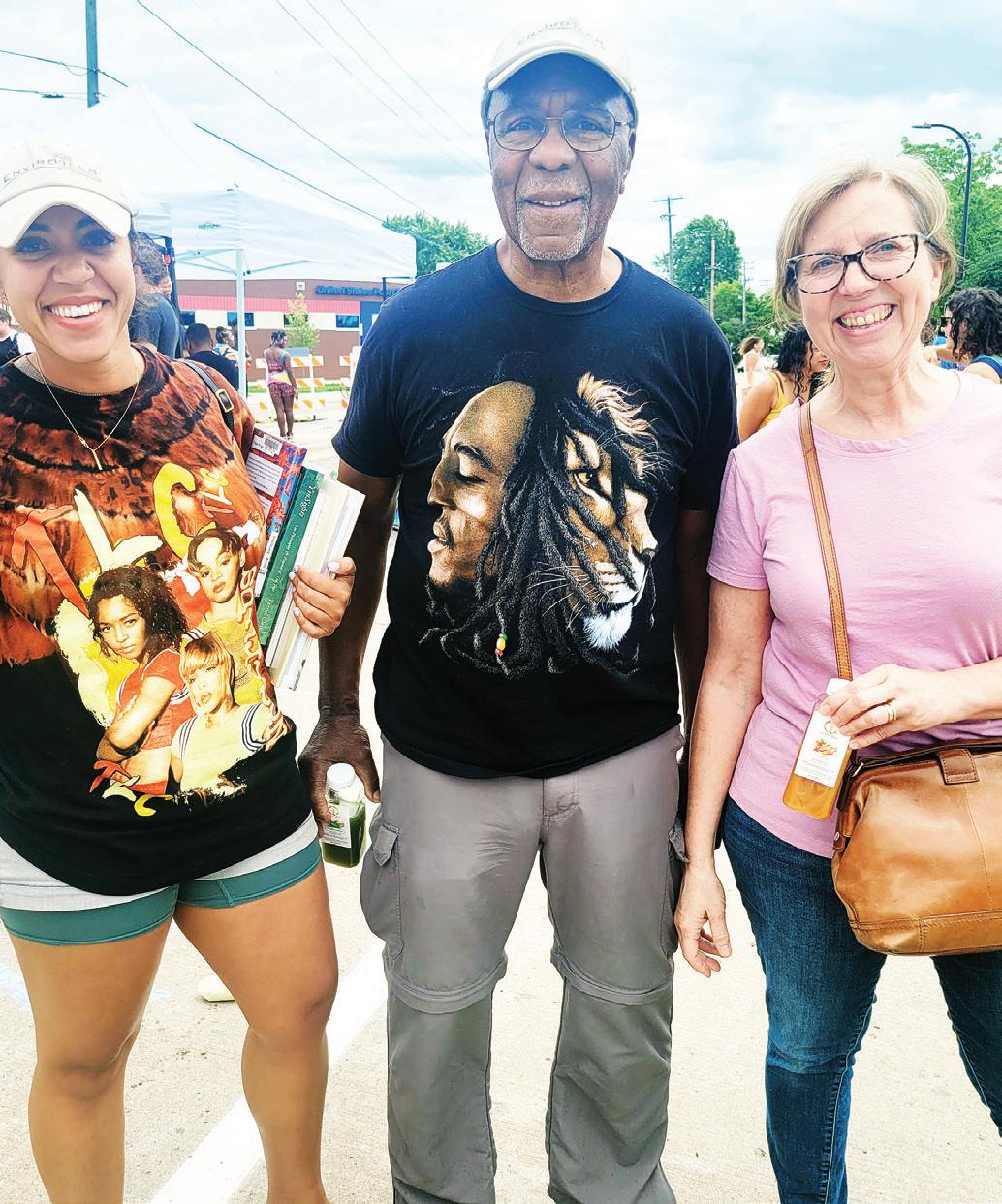
themed “The Music of Rondo.”
This event paid special tribute to the Walker West Music Academy and its founders, Rev. Carl Walker and Grant West.
The Academy, a cornerstone of the Rondo community, has long been synonymous with nurturing musical talent and preserving cultural heritage.
Concert performances highlighted the day, featuring an array of local musicians whose sounds resonated with the rich legacy of Rondo. The air was filled with genres that have been integral to the community’s cultural fabric. The stage was graced by budding artists creating a harmonious blend of the past, present and future of Rondo’s musical heritage.

Mayor Melvin Carter, Governor Tim Walz, and City Councilmember Anika Bowie were among many offering remarks
that underscored the importance of Juneteenth and the enduring contributions of the Rondo community. Their speeches resonated with themes of resilience, progress, and the ongoing journey towards equality.
Together, the Soul of the Southside Juneteenth Festival and the Rondo Avenue Juneteenth Celebration exemplified the diverse and dynamic spirit of the Twin Cities. As the sun set over Minneapolis and St. Paul, the echoes of soulful music and joyous celebration lingered, a reminder that these festivals are indeed what the community needs—a celebration of freedom, resilience, and an unbreakable bond of unity and love.
Al Brown welcomes reader responses at abrown@spokesmanrecorder.com.


By Tony Kiene Staff Writer
“Back when the tragic events surrounding Prince’s death happened, this was, for us, the beginning of what escalated into the [opioid] epidemic that we are experiencing today,” says Raphael Mattei, Assistant Special Agent in Charge with the United States Drug Enforcement Agency (DEA).
Mattei made these comments last week in Minneapolis during a public forum in memory of Prince, put together by Prince’s cousin Charles Smith, the founder and CEO of Justice4Cuz, and his wife Victoria. Established in 2016, Justice4Cuz’s mission is “to protect, preserve, and honor the legacy of Prince Rogers Nelson and to search for the truth about his life and unexpected passing.”
Serving as a platform to honor the life and legacy of his cousin, Smith likewise convened this public forum and panel discussion, moderated by WCCO-TV News Anchor and Reporter Esme Murphy, to better address the nation’s devastating opioid crisis. And, in particular, to talk about the scourge of the synthetic drug fentanyl that took the life of Prince a little more than eight years ago and the lives of hundreds of thousands of Americans since.
Fentanyl, which causes an average of one death every day in Hennepin County, is 50 times stronger than heroin and up to 100 times stronger than

morphine. Although fentanyl is largely produced in countries such as China and Mexico, it is estimated that currently 85% of the drug is dealt by Americans to other Americans.
Mattei also noted that Prince’s death on April 21, 2016, was “one of the first to be caused by what we see now, which are the fake [fentanyl] pills.” Since Prince died, fentanyl-related deaths have increased by more than 400%.
According to panelist Rick Palaia, a major in the Investigations Bureau at the Hennepin County Sheriff’s Office, the county has already seized 6,700 grams of fentanyl in 2024. This comes out to a total of 33,199 pills, each of which contains enough fentanyl to provide a fatal dose to a human being. As Murphy noted, Hennepin County’s numbers do not include data collected by the Minneapolis Police Department.
Along with Smith, Mattei and Palaia, other panelists in-
cluded Jeremy Drucker, director of the Office of Addiction and Recovery for the State of Minnesota; Alicia House, executive director of the Steve Rummler Hope Network; and Angela Kennecke, president and CEO of Emily’s Hope and the Grieving Out Loud Podcast.
Although fentanyl is largely produced in countries such as China and Mexico, it is estimated that currently, 85% of the drug is dealt by Americans to other Americans.
In 2018, Kennecke, a longtime broadcast journalist and award-winning investigative reporter based in Sioux Falls, South Dakota, was doing a story on Good Samaritan
laws and overdose prevention strategies the same day she learned that her 21-year-old daughter Emily had died from fentanyl poisoning.
“I became part of a club that I never wanted to join and one that I can never leave,” Kennecke shared with the assembled audience at Pohlad Hall in the Minneapolis Central Library.
Kennecke created the nonprofit organization Emily’s Hope in honor of her daughter and to provide individuals, families and communities with critical resources around fentanyl education, public awareness, and treatment options while having also established a Post-Overdose Response Team to “provide holistic, evidence-based care and support to those who survive an overdose.”
Emily’s Hope’s broader educational initiatives include a curriculum designed for children from kindergarten through 5th Grade. “We offer
this to schools for free as part of our mission,” she explains, “because we believe this conversation has to start younger and continue all the way through high school, through college and beyond.”
Drucker, appointed by Minnesota Governor Tim Walz in 2022 to lead the newly launched Office of Addiction and Recovery, spoke directly to some of the state’s strategies, including efforts to get Naloxone “into more and more places.” This medication can quickly reverse the effects of an opioid overdose.
Increasing access to this life-saving medication is a big part of the work being done at the St. Paul-based Steve Rummler HOPE Network, whose namesake died of an opioid overdose in July of 2011. “In 2014 Steve’s Law was passed, also known as the Good Samaritan Law, in the State of Minnesota,” says House, who leads the organization. “This allowed anyone in the state
to legally carry and administer Naloxone.”
Since then, the Steve Rummler HOPE Network has provided Naloxone education and training; worked to increase Naloxone Access Points (NAPS) across the North Star State; distributed fentanyl test strips that can detect the presence of the drug in both opioid and non-opioid pills; and developed a Naloxone toolkit for schools, among other education, outreach and advocacy initiatives.
For treatment and other supportive resources across Hennepin County, contact their Addiction and Recovery Services Unit at 612-879-3671 or visit the Minnesota Department of Human Services at https://mn.gov/ dhs/people-we-serve/seniors/ health-care/alcohol-drugs-addictions/get-help/.
Tony Kiene welcomes reader responses to tkiene@spokesman-recorder.com.






Summer is the perfect time to spend early mornings and lazy evenings outside exploring nature.
When your kids inevitably bring home pockets full of rocks, sticks, and other fantastic finds, take the opportunity to suggest some natureinspired crafts. Your kids will have fun, and you’ll find a use for those outdoor treasures. Here are eight great crafts for all ages.
Butterfly finger puppet
These butterfly finger puppets are a beautiful and fun craft using supplies from nature and are perfect for little hands. Use green cardstock to make a sturdy base with a loop for fingers, then glue leaves and flower petals on the wings—each child can dec-
orate their own and create a unique new butterfly species!
Rock tic tac toe
This craft is straightforward to make, and you can use it to spur future family game nights.
Have kids collect 10 rocks that are all relatively similar in size and as round and flat as possible. Paint Xs on half and Os on the other, then let dry. Use an old piece of cardboard, tile, or even a larger rock from the backyard to make the game board. Using painter’s tape to mark out the grid will make your lines even for a professional-looking final product.
Magic wands
Nature is a magical place, and these magic wands (made out of sticks) are an excellent way to encourage your kids to explore their powers outside. As opposed to some other crafts where the size of the sticks needs to be consis-


tent, these wands can truly be made out of any shape, length, width, and stick color.
Have each child choose their own special stick, then use yarn, paint, and other natural objects to cover and decorate them. Some glitter glue can add a bit of magical sparkle at the end, too.
Bark painting
Bark painting is an ideal craft for even the youngest crowd. It is an open-ended craft that can take 10 minutes to a whole afternoon. Have your kids collect large pieces of bark (that’s already shed off the tree), leaves, or other somewhat flat materials.
Then, use watercolors to paint various patterns and designs on the bark. Older kids can try to follow the natural curves and dents to make a pattern that reflects nature’s design. Place these finished pieces around your home for a decorative touch.
Bug hotels
You can use garden materials to make crafts that benefit… the garden. A bug hotel is an excellent place for helpful garden friends to hide out while waiting for their next meal. You can make a very simple one with some twigs, pinecones, dried leaves, and a bit of string. Using clear, plastic water bottle sides allows you

volves your kids searching for dozens of sticks, so it’s a good project to prep for throughout the summer.
Once you have enough sticks for each crown, measure a thick piece of fabric to fit each child’s head, then use hot glue to arrange the sticks. Older kids can complete the whole project on their own.
Nature critters
If your kids spend most of their time outside collecting objects to bring indoors, start a DIY nature crafting kit for all of the items they find. Fill the
plies in the crafting kit. It’s fun to see the various ways kids can make arms, heads, tails, and even whole habitats! Display your creatures along a windowsill or on the edge of a planter.
Stone wrap pendants
These wire-wrapped pendants are a fun project for older kids and teens and can be used in jewelry or decorations around the house. It’s best to collect objects that are as flat as possible so that the wire wraps more easily. Look out for stones, shells, and even
lace, keychain, or hanging pendant—the options are limitless!
These crafts highlight the versatility and beauty of nature, so get outside and start today.
The MSR + Minnesota Department of Health (MDH) share a mission of protecting, maintaining, and improving the health of ALL Minnesotans. Our shared vision for health equity in Minnesota, where ALL communities are thriving and ALL people have what they need to be healthy, is the foundation of our partnership to bring readers



MSR would like to recognize the ongoing support from community businesses and nonprofit organizations, by extending a special invitation to celebrate 90 continuous years of publishing with us. Share an elegant evening with friends, family or colleagues at this formal affair commemorating MSR's noteworthy milestone at the iconic Renaissance Minneapolis Hotel, The Depot, located in the heart of downtown Minneapolis’ Mill District.
Experience a one of a kind, walk thru historic photo exhibit and a grand gala that recalls the MSR 90 year legacy that reflects almost a century of events around our local and national community. The evening also features theatrical and musical entertainment, esteemed guests like MPR President Duchesne Drew, and emcee, MPR correspondent, Angela Davis. Your generous contribution of $1000 for five tickets as a "Community Supporter" also secures the name of your organization in a highlighted section of the newspaper and will also be mentioned at the event.
To secure five Community Supporter tickets for $1000, fill out the section below or visit our website at MSR by clicking the UR code. (Additional tickets are available). I’M A MSR COMMUNITY SUPORTER!



AUGUST 17, 2024

Continued from page 1
pride of the Black community in this achievement.
Publisher Tracey WilliamsDilliard, a third-generation publisher carrying the legacy of her grandfather, Cecil E. Newman, who founded the Minneapolis Spokesman and St. Paul Recorder in 1934, was present to receive the award.
“This award reflects the tireless work and dedication my team pours into every story,” she shared, emphasizing the MSR’s commitment to covering topics that deeply resonate with its community. “This win is a testament to our focus on delivering relevant and im-
Continued from page 1
sure that was exactly what he would do, at least not right away. “I grew up in the projects and was what you might call an ‘adventurous kid,’” laughs Cymone. “So, one day, I came across this abandoned house and made my way inside.”
He discovered in the garage stacks upon stacks of magazines spotlighting celebrities and their “Hollywood” lifestyles. “I keyed in on those images. I studied them. And whether that meant I’d have to become an actor, athlete, or a musician, I knew that’s what I wanted—that lifestyle.”
Cymone’s success at a grade school talent show, coupled with the insistence of family members that he perform on demand for guests, planted the seed that music was, indeed, the path forward. “I became the entertainer in the family. Sort of like a wind-up doll,” reminisces Cymone.
“Somebody’d always say, ‘André, show ‘em this or show
Continued from page 1
be one of only three 50-meter pools in Minnesota when installed.
Day hopes the 50-meter pool will help alleviate what he calls a “bottleneck” for competitive swimming teams in the Twin Cities. V3 is hoping to break ground on phase two construction next summer.
Executive Director of V3
Sports Malik Rucker says the
Continued from page 1
provided before ballots are mailed to the voter. Only one absentee ballot is ever mailed. Additionally, as of June 1, 2024, you can apply for a permanent absentee ballot, eliminating the need to apply for each election cycle.
Election day is not just a Tuesday in November but extends over 46 days. This is true for city, primary, and general elections. For the 2024 general election, you can vote early at your local election office from Friday, September 20, to Monday, November 4.
You do this by completing your absentee ballot at your local election office instead of mailing it. After completing your ballot, you put it into a secure box. The process of
pactful journalism.”
The article, which delved into ARAHA’s crucial work supporting Somali and Muslim communities in the U.S. and East African countries, struck a chord with the judging panel, earning the highest score in the Faith & Religion category.
The award criteria, which included layout, photography, extensiveness, variety of local coverage, and comprehensiveness of stories, underscored the MSR’s skill in crafting compelling narratives that deeply touch the reader.
Less than two months from the MSR’s 90th anniversary, Williams-Dilliard expressed profound pride in her team, recognizing their unwavering commitment to excellence.
“This recognition serves as a
‘em that.’ So, I’d do my James Brown routine, or Jackie Wilson, things like that.”
After the Anderson family moved to Russell Avenue North, Cymone began junior high school “not really knowing anyone at all.” The fact that he didn’t care much for authority immediately brought him into conflict with his new gym teacher.
“This recognition serves as a driving force for us to continue pursuing excellence in everything we do.”
driving force for us to continue pursuing excellence in everything we do,” she affirmed, adding that this win fuels a desire for continued success in future awards. “It’s beautiful to see our talented journalists and the MSR be recognized nationally.”
The MSR’s win at the NNPA Messenger Awards is a testament to journalistic skill and reflects the publication’s unwavering commitment to its commu-
Yet it soon became clear how serious each of them was. And when they discovered by happenstance that their fathers were once in a band together, this only helped to cement their bond.
“It seems that music is slipping away from people’s consciousness. I want to go back to that energy, those sensibilities, that attitude. The spirit of funk, so to speak.”
“I didn’t like his brand of telling me what to do. That didn’t work for me, so we had words,” Cymone recalls. “Then there’s this other kid that says to me,
‘You are going to get us in trouble.’ I looked at him and was like, ‘And who are you?’”
That other kid just happened to be Prince Rogers Nelson, and by inserting himself into the moment, he serendipitously established a brotherhood between the two.
Both youngsters claimed to be musicians, but neither believed the other at first.
facility saw use by thousands of people during the limited hours in the past month, about 350 of whom got memberships.
Rucker says the idea behind the facility was to replace many of the programs cut after the YMCA on Broadway was repurposed into a community center.
“We wanted to create a space for health, wellness, and water safety,” Rucker said. V3 currently offers many fitness and swimming programs. The facility is also a Boys and Girls Club location.
Day says one of the biggest
counting absentee ballots begins 18 days before the election.
Whether you submit your absentee ballot by mail or in person, you must provide your name, address, driver’s license number, State ID card number, or the last four digits of your social security number. No ballot is counted until the members of the Absentee Ballot Board have verified it. Each ballot is given a unique barcode and is entered into the state’s voter registration system, which allows you to track the status of your absentee ballot on the Secretary of State’s website.
If you need assistance to vote, you can bring someone to help or get assistance from election judges. You can access a machine that can mark a ballot for you if you cannot do this on your own. If you cannot easily leave your vehicle,

nity. Since its inception, the MSR has been a steadfast voice for the Black community, advocating for social justice, amplifying marginalized voices, and provid-
ing a platform for critical conversations that shape the future of the Twin Cities. This latest award underscores the enduring legacy of
the MSR, a legacy built upon a deep understanding of its community, a passion for storytelling, and an unwavering dedication to journalistic integrity.
As the MSR continues to evolve and adapt to the changing media landscape, this award is a powerful reminder of its enduring relevance and impact. The publication’s unwavering commitment to its mission and dedication to impactful storytelling, particularly for the Twin Cities Black community, ensures that the MSR will continue to play a vital role in the community’s fabric for future generations.
Al Brown welcomes reader responses at abrown@spokesmnrecorder.com.
They formed Grand Central with Prince’s cousin Charles Smith. Cymone rounded out the rest of the group by bringing in his sister Linda, Terry Jackson, the late William “Hollywood” Doughty, and Morris Day, who would replace Smith on drums.
“I wanted us to stand out, to be seen as original, as innovators,” Cymone says. “We knew how to write songs, and we were outshining bands much older than us.”
Prince spent the better part of that time living in the Anderson home. And when Prince signed with Warner Bros. Records in 1977, Cymone, despite his own dreams and aspirations, understood,
parts of V3’s mission is water safety and preventing drownings. Black communities have much higher rates of drowning per capita on average, with Black adults being much less likely to know how to swim than white adults. Day says that the swimming lessons offered will be trauma-informed and culturally specific to help kids who may have had a drowning in their family or a near-drowning experience themselves.
The swim program is rooted in a study by local Black researcher Dr. Ayanna Rakhu,
you can have a ballot brought out to you. Two election judges from different parties monitor curbside voting. They bring you the ballot, return it to the polling place, and put it on the ballot counter.
For the 2024 general election, you can vote early at your local election office from Friday, September 20 to Monday, November 4.
Security
What happens to your ballot after you vote? MN uses
“This is my friend. I have his back, whatever he needs.”
So, with Cymone on Prince’s right-hand side and guitarist Dez Dickerson on the left, the three men formed one of the most impressive front lines you’ll ever see on stage.
After three albums and as many tours with Prince, Cymone signed a deal with Columbia Records. He released three innovative solo albums while also establishing a side project of his own, The Girls.
“When I went out on my own, I was creating a different style of music, something fun, futuristic,” explains Cymone. “But the label started sweating me, wanting me to sound like Prince.
“Sure, I could have done that. I helped create all that. My bass is what drove that sound. But that wasn’t what I was doing anymore.”
Cymone left Columbia and soon went on to write, produce, and perform on most of Jody Watley’s debut album (plus three more), which garnered her a Grammy for Best New Artist, at the same time letting his former label and the world know that “Yes! I can still do all that.”
“We wanted to create a space for health, wellness, and water safety.”
whose doctoral thesis at the University of Minnesota studied why Black children are less likely to know how to swim.
Maya Marchelle, a Northside resident who hosted the grand opening, said she planned to take advantage of
ballot-counting machines to tabulate the votes. If you vote with an absentee ballot, it is processed by the state’s Absentee Ballot Board. They are kept in secured storage until 18 days before the election.
Then, two board members from different parties open and review the ballots. Teams of two board members from different parties process these ballots using the same counting machines to count in-person ballots on election day. What happens to your paper ballot after it is counted?
These ballots are placed in ballot transfer cases and sealed with two certification seals.
The roster of artists that Cymone has since written and produced for is as diverse as it is long. It includes Tina Turner, Tom Jones, Evelyn ‘Champagne’ King, James Ingram, Adam Ant, Pretty Poison, Pebbles, Jermaine Stewart, and many more.
By 2012, Cymone was releasing his solo work again, beginning with the single “America,” written in support of President Obama’s re-election campaign. Soon to follow were the songs “Trayvon,” “My Best Friend” (a tribute to his mother Bernadette), and his first solo album in 29 years, 2014’s “The Stone.”
Following the EP “Black Man in America” was yet another critically acclaimed offering from Cymone, the album “1969,” evoking an era when musical artists weren’t afraid to “speak truth to power” and sang about the world in which they lived.
“It’s important that artists use their platform to address the issues of the day. What is relevant to our times,” asserts Cymone. “There are some ominous things going on in the world today, and those tend to hit Black people first and hardest. Our nation has been hol-
the swimming lessons to learn how to swim. Marchelle said many of her friends growing up did not learn how to swim because they could not afford lessons. She did not learn because of a stigma around hair, with her mother saying she could not get her hair wet if it had just been done.
Eisha Marshal attended the grand opening with her daughter, Carliegh Hall. In the past month, Marshal and Hall bought a membership at V3 because it was a “less stressful” environment for Hall to swim
All of this is done by two election judges (one must be either the head or assistant head election judge) who sign forms throughout the process. The sealed ballot boxes are transferred to Hennepin County Elections and stored for 22 months.
Accuracy
How is counting votes secure so you can be confident that your vote will be counted?
Paper ballots are the cornerstone of ballot security in Minnesota. They provide a record of everyone’s vote and facilitate any post-election audits to verify the accuracy of ballot counting machines if needed.
Your paper ballot is tabulated using a ballot counting machine. Research comparing the accuracy of hand-counting votes and counting machines shows that using machines is faster and more accurate than hand counting.
You can be confident that these ballot-counting machines will function accurately on election day. Testing is done before and after elections to certify the accuracy of these machines. The machines
lowed out. People are scraping just to get by.”
In addition to his socially conscious work, Cymone’s songwriting runs the gamut of musical genres. “I’ve written and recorded so many things. Classical, jazz, reggae, rock. A bunch of different things.” Nonetheless, for Cymone, 2024 has got to be the Summer of Funk. “Like I said, I just want to reestablish my connection to that element of the Minneapolis Sound. That funk aspect of it all. To bring it back to where it originally was.”
Cymone has created such an abundance of funk with this project that he finds it difficult to contain his excitement, wanting to share that feeling with everyone.
The plan is to start releasing a little bit of funk here and there on the way to the full release of The Resurrection of Funk. That first song, “Funk is Alive,” drops on June 27. You can hear it by visiting andrecymone.bandcamp.com/track/ funk-is-alive.
Tony Kiene welcomes reader responses at tkiene@spokesman-recorder.com.
in, and Marshal says it felt safer than the YMCA. Marshal hopes V3 will create a youth swim team that Hall can join.
Memberships to the V3 Sports Center can be purchased online at v3sports.org or in person at 701 Plymouth Ave N, Minneapolis. Memberships cost between $38 to $51 per month. Day passes and swim passes are also available.
Cole Miska welcomes reader responses to cmiska@spokesman-recorder.com.
purchased in Minnesota to count your vote have been tested for accuracy and certified by test labs approved by the U. S. Election Assistance Commission.
After the election, counties randomly select precincts where election results are audited. Hand counts of paper ballots are compared to machine counts. These audits are also open to the public. Voting in Minnesota is secure due to a comprehensive system of safeguards and protocols designed to protect the integrity of the electoral process.
This is the second article in the League of Women Voters Minneapolis 2024 Democracy Series. Next month, the third article in our series, “AI and How it Can Impact Elections,” will describe the role artificial intelligence may play in our elections.

By Chris Juhn Contributing Writer
Dr. Nana Wilmot-DeSouza
is the owner of Arise Medical and Wellness, now thriving in its second year. Specializing in primary care and immigration health services, Arise Medical and Wellness is committed to providing comprehensive, compassionate care to the community. Dr. Wilmot-DeSouza (W-D) now employs a full-time team of three.
MSR: What inspired you to launch/start your business?
W-D: Well, as a physician I knew there was a better way to do health care and not make it so large, but make it personal and make it more accessible for people who look like me, and people who felt like they were just looking for something extra—a more personal touch to medicine.
MSR: Tell me a little bit about your practice.
W-D: Our practice is centered around primary care and lifestyle medicine. I’m a boardcertified family and lifestyle medicine physician, so lifestyle medicine is a form of medicine that incorporates nutrition, exercise and relationships. You know, all of those things that we don’t pay attention to, but are actually an important part

of medicine.
We do medical weight loss, nutrition, health coaching, and refugee health.
MSR: I read on your website that you do missions trips. Tell me about that.
W-D: I started doing medical missions in college. I do one every year in Honduras. There’s a hospital there called the Jungle Hospital. The most incredible moment is seeing the gratitude that the people have for you.
And it’s simple medicine that we do out there. But it’s the most gratifying because you actually see tangible changes in them and it’s often just the little moments. That’s what makes it the most impactful for me.
They have a lot of back and knee pain. Also it’s just as simple as Tylenol. I’ll give it to them and they’re overjoyed that somebody gave them Tylenol. Or, you know, they were out in the sun a lot, so just giving them sunglasses to pro-
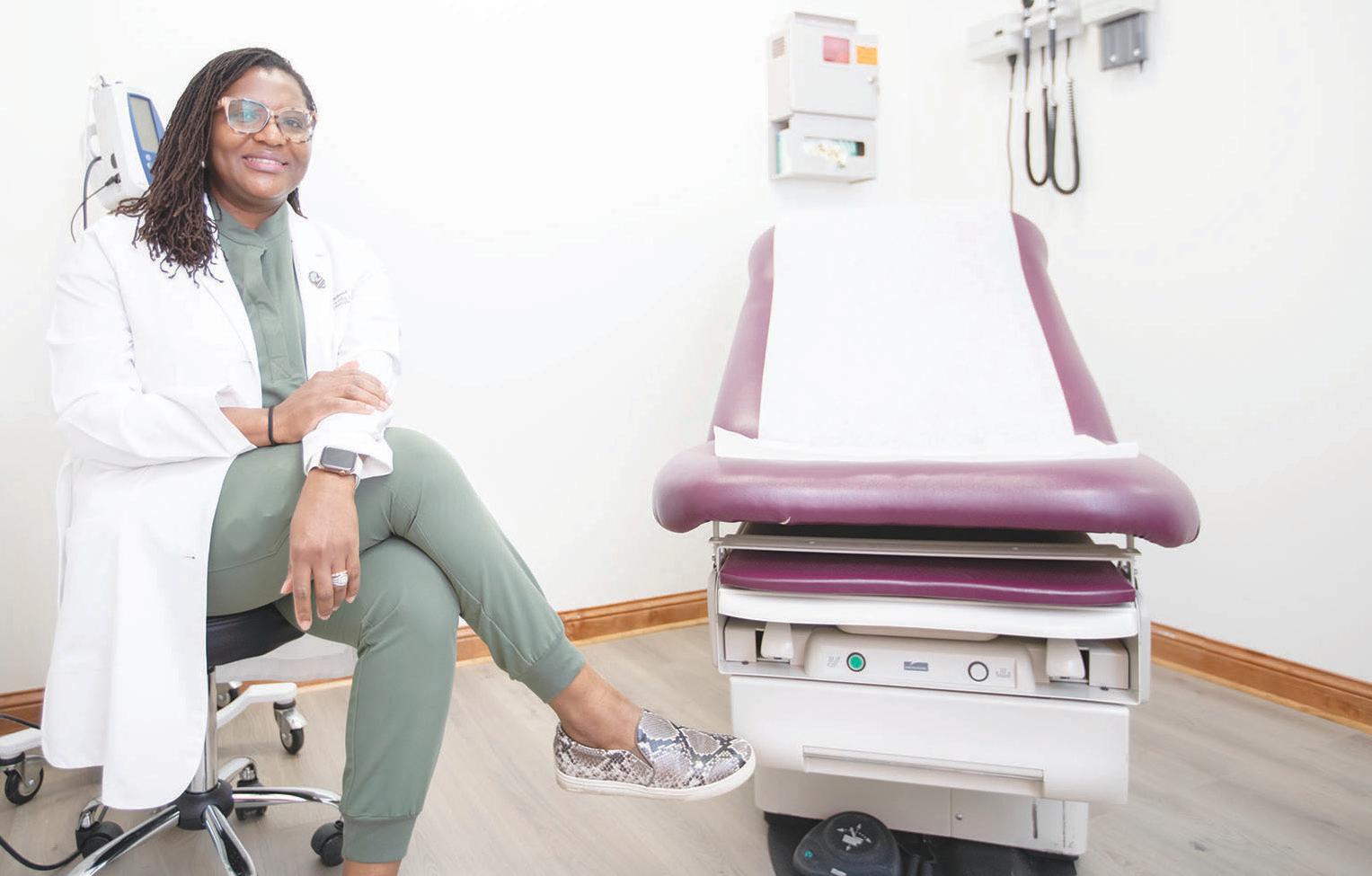
tect their eye health or teaching them how to eat better.
So it’s training them to use the resources they have to live better and healthier.
MSR: How does your business impact the community?
W-D: Our business model is to have people know that we are here for them, because oftentimes people go to these places and it’s like they’re not
heard. And so we want them to know we are here. We can listen to you and we can identify with what you’re going through.
In terms of culture, I feel like cultural competence is the biggest thing that’s missing in health care, and we’re able to provide that in a unique way because of our personal experiences.
MSR: What would you consider your business’ hero service or product?
W-D: Immigration health is big because Minnesota has a huge immigrant population and often they are looking for a place where they can do their exams to be able to move on to get a green card. And so we do quite a bit of that along with
primary care. So those are the two biggest things we do.
MSR: What has been your biggest challenge in owning a business?
W-D: Resources are the hardest—knowing who to contact, where to go, what to do. I feel like those are the biggest hurdles as a small business that you don’t have compared to the larger health systems. They have all the resources at hand. But for us, every little bit matters.
MSR: What has been the most rewarding part of owning your business?
W-D: Changing people’s lives. Seeing that some people come to me mostly because
I’m African American or, you know, I have Kenyan lineage. And so they come to me. I can speak their cultural language. I am conversant in Spanish. And so people appreciate that. And so seeing a diabetic, you know, who did not have much success, but now we can say, listen, if you want to eat a taco, we’ll make it this way, do it this way, do it that way. So that’s the most rewarding because we can siphon the big things and make it applicable to their life stories so that it matters to them and it changes the trajectory of their health.
MSR: What’s your vision/ goals for your business? What does success look like for you?
W-D: Our vision is to grow it into multiple cities, so not just the Savage Lake area, but go to South Minneapolis and different areas. But most of all, to provide culturally competent care no matter where we find ourselves. To do it with excellence and to be sure we are leaving a blueprint for people to follow.
Arise Medical and Wellness is located at 7747 Eagan Drive, Suite 207, Savage, MN 55378. To reach Dr. Wilmot-DeSouza, or to learn more about the services, call 952-522-6344, or visit their website at www.arisewellnessmed.com.
Chris Juhn welcomes reader comments at cjuhn@spokesman-recorder.com.




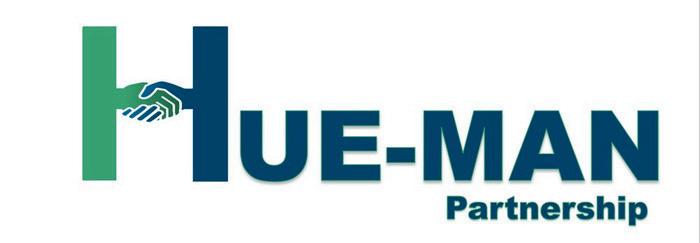

By Tony Kiene Staff Writer
“A lot of people have suggested that Prince was jealous of the Flyt Tyme horns,” says Robert ‘Bird’ Martin, “but I don’t think jealous is the right word. Envious is more accurate, and there is a difference between the two. We simply had something that Prince didn’t have in Grand Central.”
Martin, who first helped to put the Wars of Armageddon together, which shortly thereafter became known as Flyt Tyme, played trumpet in the band that competed against Grand Central and other local groups for musical supremacy on the North Side of Minneapolis and beyond.
Martin also chose the name Flyt Tyme, inspired by a 1973 song of the same name by legendary jazz trumpeter Donald Byrd. “I just changed the spelling a little,” Martin chuckles, “swapped out the ‘i’s for ‘y’s.”
“Our horns separated us from the other bands of the day,” adds tenor saxophonist Jimmie ‘Chipmunk’ Anderson, who, along with Martin, David ‘Batman’ Eiland (alto saxophone), and “Big” Bob Johnson (trombone]”, eventually rounded out Flyt Tyme’s original horn section. “We were blowing people out of the water.”
The band was influenced by the Tower of Power, Kool & the Gang, Chicago, the Ohio Players, and Blood, Sweat & Tears, among others, all of
which featured horns heavily in their music.
“It wasn’t just the hits we played when covering this stuff,” Anderson explains. “We got into the more intricate, dynamic album tracks, things you wouldn’t hear on the radio.”
“That’s right,” Martin interjects. “After all, we had David [Eiland], who, as an alto sax player, was second to none in this town. Everyone was just in awe of his talent. He set the bar so high that he pushed the rest of us to improve. That’s why we rehearsed every day.”
“Our horns separated us from the other bands of the day. We were blowing people out of the water.”
Back in the band’s early days, the horns were frequently positioned at the center of it all.
And these guys didn’t just play their instruments; they added choreography. And, of course, there were the costumes.
“We were a really big attraction. I mean, we were showmen,” affirms Anderson. “Terry [Lewis], Jellybean [Johnson], Joey [Kareem], the rest of the band were behind us or off to the side a bit.

Our horn players were at the front of the stage when we first got started. That was all part of our presentation.”
That all changed when Cynthia Johnson joined Flyt Tyme as the new lead singer, occasionally adding her skills on the saxophone as well. But the move also increased the band’s repertoire, opened new doors, and, as Anderson says, “took us to another level, made our show even bigger.”
Over the years, others would be welcomed into the fold with Flyt Tyme, including David Wright, who replaced Martin in the horn section.
Several of those in the band’s final lineup, not including the horn players, were absorbed into what became Prince’s most successful side project ever, Warner Bros. recording
METRO Blue Line Extension Supplemental Draft Environmental Impact Statement –Notice of Availability and Public Hearing
The Metropolitan Council and the Federal Transit Administration have prepared a Supplemental Draft Environmental Impact Statement (SDEIS) for the METRO Blue Line Extension project. This document evaluates the potential social, economic, and environmental benefits and impacts that may occur because of the design, construction, and operation of the Blue Line Extension and outlines potential measures to avoid or reduce those impacts.
The environmental review process for the METRO Blue Line Extension is required by the National Environmental Policy Act and the Minnesota Environmental Policy Act.
The SDEIS is available on the project website at BlueLineExt.org and printed to view at the following locations:
• Blue Line Extension Project Office, 6465 Wayzata Boulevard, Suite 600, St. Louis Park, MN 55426
• Brooklyn Park Library, 8500 West Broadway Avenue, Brooklyn Park, MN 55445
• Rockford Road Library, 6401 North 42nd Avenue, Crystal, MN 55427
• North Regional Library, 1315 Lowry Avenue North, Minneapolis, MN 55411 Public comments can be submitted through one of these options:
• Submit a comment online at BlueLineExt.org.
• Call the SDEIS project hotline at 612-373-3970 to record your comment.
• Email comments to BlueLineExt@metrotransit.org.
• Provide written comments at a Public Hearing or other events listed on the website.
The SDEIS comment period is open until August 5, 2024. Public comments received during this period will be addressed and published in the Supplemental Final Environmental Impact Statement (SFEIS), which is anticipated to be published mid-2025.
To afford an opportunity for interested people, agencies, and groups to comment on the SDEIS inperson, two public hearings are anticipated:
• Tuesday, July 16, 2024, 5 p.m. - 7 p.m. at NorthPoint Conference Center, 1256 Penn Avenue North, Suite 5200, Minneapolis, MN
• Tuesday, July 23, 2024, 10 a.m. – noon, Brooklyn Park Library Mississippi Room, 8500 West Broadway Avenue, Brooklyn Park, MN
If you need assistance to participate in public meetings or have general accessibility inquiries, please contact Kaja Vang at Kaja.Vang@metrotransit. org. Requests for special assistance should be made a minimum of seven business days in advance of the scheduled meeting.
Visit BlueLineExt.org to learn more.
artists The Time.
Of course, Flyt Tyme’s legacy lives on today in many ways. However, one that is sometimes overlooked is the influence of those amazing Flyt Tyme horns.
“Since Prince didn’t have any horns in Grand Central, or those first several years after he signed with Warners, he found a way to create his own,” observes Martin.
Prince’s innovative use of synthesizers to recreate horn parts in many of his early compositions became one of the distinguishing features of the Minneapolis Sound, but also significantly influenced pop, rock and soul music for the better part of the 1980s and ‘90s.
“None of us ever thought about making it in the music business. We just loved to play and were having fun,” Anderson remembers. “And we found the right characters in the Flyt Tyme horns. We just blended so well together. It was the perfect match.”
Flyt Tyme reunited live on stage in 2018 for the Super Bowl VII festivities in downtown Minneapolis, with nearly everyone who was ever in the band taking part in the show.
“It was nice to be recognized for our history that night,” says Martin, “We’d come full circle.”
When reflecting on Flyt Tyme’s legacy in an even broader context, Martin and Anderson agree that sharing
their music with others was what it was all about.
“We were trying to put love into the community. And a nice cross-section of people came to see us,” recalls Anderson, “white folks, other folks, other bands even. All who heard about Flyt Tyme’s ‘badass’ horn section.”
Of all the members of Flyt Tyme, only Big Bob Johnson is no longer with us, having passed away in 2023. “Bob is so dearly missed,” says Martin. “He was imposing but still the biggest-hearted, most gentle man you could ever meet.”
Tony Kiene welcomes reader responses to tkiene@spokesman-recorder.com




As the Minnesota Spokesman-Recorder approaches its 90th anniversary, you’re invited to commemorate this historic milestone by donating $90 to celebrate 90 years of continuous publication.
Your generous contribution will support our legacy of dedicated community empowerment through journalism and ensure our vital work continues into the future.
As a “$90-for-90” contributor (non-business), your name will be prominently displayed in our print and digital editions until the week of Aug. 10 — the date of our founding in 1934.
Please consider this unique opportunity to stand collectively with the MSR, honoring 90 years of tradition and community service. For inquiries or to join as a “$90-for-90” supporter, call 612-827-4021, visit our website, or email admin@spokesman-recorder.com.
Torrion Amie
Ray Seville Productions
Holly Andersen
Kimerlie Geraci
Jonathan Beck
David Fettig
Clara Boykin & Family
Tracy Wesley
Gretchen Bratvold
Amanda Brinkman
The O’Neill Family
Toweya Brown-Ochs
Liam Cavin
Deanna Callender
Your Name Here
Liam Cavin
Your Name Here
Janis Clay
Your Name Here
Edward Coblentz
Your Name Here
Michael Davis
Your Name Here
Victoria Davis
Michael Diehl
Your Name Here
April A. Estes
Your Name Here
George Ewing
Your Name Here
Elizabeth Fealey
Your Name Here
David Fettig
Your Name Here
Readus Fletcher
Your Name Here
Lee Friedman
Kimerlie Geraci
Your Name Here
Leota Goodney
Your Name Here
Angelo Hughes
Your Name Here
Katie Izzo
Your Name Here
Nina Johnson
Your Name Here
Clarence Jones
Your Name Here
Your Name Here
Debra Jones
Your Name Here
Nathaniel Khaliq
Michele Livingston
Your Name Here
Harlan Luxenberg
Your Name Here
Melanie Manaen
Your Name Here
Deborah Montgomery
Your Name Here
Debbie Morrison
Your Name Here
Marcia Murray
The O’Neill Family
Your Name Here
Ray Seville Productions
Your Name Here
Mary Quinn McCallum
Your Name Here
Patty Ploetz
Your Name Here
Mark Ritchie
Your Name Here
Lyn Rabinovitch
& John Saxhaug
Your Name Here
Augustus Ritemon
Your Name Here
Carolyn Roberson
Your Name Here
St. Paul Saints
Your Name Here
Elizabeth Schutz
Dotty Timmons
Your Name Here
Bill Wells
Your Name Here
Tracy Wesley
Your Name Here
Jeffery Young
Your Name Here
Your Name Here
Your Name Here
Your Name Here
Your Name Here
Your Name Here
Your Name Here
Your Name Here
Your Name Here
Your Name Here
Your Name Here
Your Name Here
Your Name Here
Your Name Here
Your Name Here
Your Name Here
Your Name Here
Your Name Here
Your Name Here
Your Name Here
Your Name Here
Your Name Here
Your Name Here
Your Name Here
Your Name Here
Your Name Here
Your Name Here
Your Name Here
Your Name Here
Your Name Here
Your Name Here
Your Name Here
Your Name Here
Your Name Here
Your Name Here
Your Name Here
Your Name Here
Your Name Here
Your Name Here
Your Name Here
Your Name Here
Your Name Here
Your Name Here
Your Name Here
Your Name Here
Your Name Here
Your Name Here
Your Name Here
Your Name Here
Your Name Here
Your Name Here
Your Name Here
Your Name Here
Your Name Here
Your Name Here
Your Name Here
Your Name Here
Your Name Here
Your Name Here
Your Name Here
Your Name Here
Your Name Here
Your Name Here
Your Name Here
Your Name Here
Your Name Here
Your Name Here
Your Name Here
Your Name Here
Your Name Here
Your Name Here
Your Name Here
Your Name Here
Your Name Here
Your Name Here
Your Name Here
Your Name Here
Your Name Here
Your Name Here
Your Name Here
Your Name Here
Your Name Here
Your Name Here
Your Name Here
Your Name Here
Your Name Here
Your Name Here
Your Name Here
Your Name Here
Your Name Here
Your Name Here
Your Name Here
Your Name Here
Your Name Here
Your Name Here
Your Name Here
Your Name Here
Your Name Here
Your Name Here
Your Name Here
Your Name Here
Your Name Here
Your Name Here
Your Name Here
Your Name Here
Your Name Here
Your Name Here
Your Name Here
Your Name Here
Your Name Here
Your Name Here
Your Name Here
Your Name Here
Your Name Here

Is Earth really getting too hot for people to survive?
By Scott Denning
Many countries have seen extremely hot weather lately, but in most of the inhabited world, it’s never going to get “too hot for people to live here,” especially in relatively dry climates. When it’s hot outside in dry places, our bodies can usually cool off by evaporating water and heat from our skin as sweat.
When people burn carbon— whether it’s coal in a power plant or gasoline in a vehicle—it creates carbon dioxide (CO2). This invisible gas builds up in the atmosphere and traps the sun’s warmth near the earth’s surface. The result is what we mean by “climate change.”
Good news and bad
There’s both bad and good news about climate change in the future. The bad news is that as long as we keep burning carbon, it will continue to get hotter and hotter.
By Keith Boykin
If you want to know why Black people don’t vote for Republicans, just look at the Black Republicans.
America’s top Black Republican, Tim Scott, claims that “woke supremacy is as bad as white supremacy.” What on earth is woke supremacy?
Scott is so desperate for white approval that he voted against the first Black woman on the Supreme Court, Justice Ketanji Brown Jackson, even while three of his white Republican colleagues voted for her.
Then there’s Byron Donalds, who claimed that “the Black family was together” under Jim Crow. Donalds is one of 26 House Republicans who refused to sign a letter denouncing white supremacy. He was one of only two Black members of Congress who voted to overturn the 2020 election results, which would have disenfranchised Black voters in Philadelphia, Detroit, Atlanta, and other cities.
And just in time for Juneteenth, three Black Republicans in the House of Repre
sentatives (Donalds, Burgess Owens, and Wesley Hunt) voted to restore a racist Confederate monument at Arlington National Cemetery.
Republicans love Black people—who love white people.
Tim Scott and Byron Donalds have an excuse, but it’s not a good one. They are so desperate to be Trump’s running mate that they refuse to upset his base or hold him accountable even after he was convicted of 34 felonies. What Black man with 34 felony convictions gets a pass from Republicans?
But one of the most notorious Black Republicans today is North Carolina gubernatorial candidate Mark Robinson.
Robinson tells Black people, “Nobody owes you anything for slavery,” and invokes the history of Black abolitionists and civil rights leaders to excuse white people from accountability. “If anybody owes, it’s you,” he says.
Robinson became popular in the GOP precisely because he loves to attack Black people. He called the “Black Panther” movie “trash” made by a “satanic Marxist,” said that Halle Berry, Mariah Carey and Issa Rae wear “whore dresses,” and repeatedly misgendered former first lady Michelle Obama as a man.
that Donald Trump’s indictment was “probably the most egregious thing I’ve ever seen in the history of our republic.”
Was he kidding?
Or Ben Carson, the Trump appointee who thinks systemic racism ended with the Civil Rights Movement, who says Colin Kaepernick would never have been criticized if he had just said he loved America and claims that Obamacare is the “worst thing that has happened in this nation since slavery.”
Really, Dr. Carson? Providing health care to Black people is worse than segregation, lynchings, and mass incarceration?
However, there are places where it occasionally gets dangerously hot and humid, especially where hot deserts are right next to the warm ocean. When the air is humid, sweat doesn’t evaporate as quickly, so sweating doesn’t cool us the way it does in drier environments.
In parts of the Middle East, Pakistan and India, summer heat waves can combine with humid air that blows off the sea, and this combination can be truly deadly. Hundreds of millions of people live in those regions, most without access to indoor air conditioning.
Every bit of coal, oil, or gas burned raises the temperature a little bit more
Every bit of coal, oil, or gas burned raises the temperature a little bit more. As temperatures rise, dangerously hot and humid weather has begun to spread to more places.
Areas of the U.S. Gulf Coast in Louisiana and Texas are increasingly at risk of dangerous hot and humid conditions in summer, as are heavily irrigated areas of the desert Southwest where water sprayed over farm fields adds moisture to the atmosphere.
The good news is that we can substitute clean energy, like solar and wind power, instead of burning carbon to power the products and services of modern life. In the past 15 years, tremendous progress has been made in making clean energy reliable and affordable, and almost every country on Earth has now agreed to stop climate change before it causes too much damage.
Just as our ancestors built better lives by switching from outhouses to indoor plumbing, we will avoid making our world unlivable by switching from coal, oil and gas to clean energy.
Scott Denning is a professor of atmospheric science at Colorado State University.
Then there’s Winsome Sears, the gun-toting Virginia lieutenant governor, who is upset because she thinks critical race theory is being taught in schools. It’s not.
Next up is Daniel Cameron, the former Kentucky attorney general who said the police killing of Breonna Taylor was “justified” and declined to charge the officers responsible for her death. I guess Black lives really don’t matter to Republicans.
Or how about Larry Elder?
The 72-year-old Black Republican lived through Jim Crow segregation, Rosa Parks’s arrest, and Dr. King’s assassination, but he told Fox News

submissions@spokesman-recorder.com.
And we can’t forget Herschel Walker, the former football player who lied about being his high school valedictorian, lied about graduating from college, had no experience in government, and didn’t even live in Georgia when Republicans recruited him to run for the Georgia Senate seat against Raphael Warnock. Walker’s own son, Christian, admitted that his father was picked mainly “because he was the same skin color as his opponent.”
After years of Republicans weaponizing Dr. King’s line about judging people “by the content of their character,” when it came time to pick a candidate to run against Rev. Warnock, the pastor of Dr. King’s church, they picked an inexperienced Black guy based on the color of his skin.
Last but not least is Clarence Thomas, the Harlan Crowfunded Black conservative who replaced the legendary Thurgood Marshall on the U.S. Supreme Court through affirmative action and then joined five of his white colleagues to kill affirmative action for everyone else. Thomas also cast the decisive vote to gut the Voting Rights Act that protects Black people at the polls.
What these Black Republicans have in common is that none of them were chosen by Black people. They may have been born in Black communities decades ago, but none of them represent Black districts or interests. That means they have no accountability to the majority of Black Americans.
And that’s important because Black and white people, like Democrats and Republicans, see the world differently.
“Black Vote, Black Power,” a collaboration between Keith Boykin and Word In Black, examines the issues, the candidates, and what’s at stake for Black America in the 2024 presidential election.
Keith Boykin is a New York Times–bestselling author, TV and film producer, and former CNN political commentator.
This commentary is republished with permission from Word in Black.
By Dr. Benjamin F. Chavis, Jr.
By responding to concerns the African American community has expressed about proposed regulatory and administrative policies, the Biden-Harris administration has proven to be a responsive champion of minority voices and interests.
Through the Affordable Connectivity Program, the Biden-Harris administration connected over five million Black households to affordable, high-speed internet, bridging the digital divide for millions of African American families across the nation.
As the Biden-Harris 2024 presidential campaign continues to gain momentum among African Americans and other communities of color, I encourage the campaign to remain responsive to the issues and needs of those communities that will provide a solid base for the Democratic Party in the 2024 national elections.
Recent national polls continue to indicate that the Biden-Harris campaign still has some work to do to match the Democratic voter turnout that was achieved in 2016 and 2020, so responding to these concerns can pay significant dividends in this respect.
One area where Biden-Harris can energize African American voter turnout is addressing their frustration over the rising cost of living, which is often driven by higher energy prices. According to the Bureau of Labor Statistics, this kind of economic pain has fallen more on Black Americans than white Americans.
I applaud my friend and colleague Environmental Protection Agency (EPA) Administrator Michael Regan, who has been a strong advocate for environmental justice and equality for all Americans, particularly minority communities.
In a recent speech at my Alma mater, Howard University, one of the nation’s most prominent Historically Black Colleges and Universities (HBCUs), Regan announced that the EPA would like to eventu-
ally shut down existing coal plants and ban new natural gas plants unless they implement carbon capture technologies that are now emerging in the energy sector.
In his remarks, Regan argued that the mandates are necessary to protect “communities of color” from hazards at coal and natural gas power plants that do not employ carbon capture goals and objectives. Unquestionably, I know where the administration’s heart is on this issue.
However, those proposals will possibly make electricity more expensive and, at times, less reliable—disproportionately hurting minority consumers. Moreover, many of the new natural gas plants targeted by EPA provide reliable critical backup energy sources. That said, Regan presents some valid points, and the administration can, without question, find a solution to this issue that pleases all its voter bases.
A strong economy can and should contribute to sustaining environmental and climate matters.
That process can begin by creating a Biden-Harris Sustainable Development Council.
President Bill Clinton established the President’s Council on Sustainable Development back in 1993.
The successful purpose of that council was to bring together leaders of environmental and climate justice with the leaders of energy, commerce and others in corporate America, including leaders from the coal and gas industries, to jointly explore ways to strengthen America’s economy and protect the environment and climate at the same time.
Former U.S. Secretary of Commerce Ron Brown chaired the President’s Council on
Sustainable Development. I was very pleased to represent the interests of the Environmental Justice Movement as an active member of the council. I am convinced that President Biden, Vice President Harris, and Administrator Regan re-establishing the President’s Council on Sustainable Development will allow them to find a way to implement an all-of-the-above energy approach that works for everyone by working directly with the Congressional Black Caucus Energy Braintrust, major urban mayors, elected officials, energy industry leaders, and with the advocates of climate change and the leaders of the Environmental Justice Movement.
The National Newspaper Publishers Association (NNPA), where I serve as the president and CEO, welcomes the opportunity to participate in such an ongoing effort and council. More clean energy initiatives are needed, and proposing them should remain a priority for the administration.
That said, the new EPA policy rule on existing coal and natural gas plants should be done in a manner that protects the environment and climate while also enhancing the economy. The administration needs to ensure that new, well-intentioned mandates will not have the unintended consequences of making electricity more expensive, especially for underserved communities.
I am confident that the energy-impacting proposals now under review by EPA Administrator Regan and the BidenHarris Administration will consider the issues I am raising with the ultimate goal of sustainability for the environment, climate, and the economy.
Dr. Benjamin F. Chavis, Jr. is president and CEO of the National Newspaper Publishers Association (NNPA) and a lifelong civil rights and environmental justice leader who can be reached at dr.bchavis@nnpa.org. This story is republished with permission from The Conversation.
By Dr. Artika Tyner
Children are naturally curious and creative. They like to play, tinker, build and explore. These are all key components of STEM [Science, Technology, Engineering and Math] education. Imagine creating learning opportunities to help introduce children to STEM learning early. This would aid children in developing core competencies like communication, confidence, critical thinking, and collaboration. STEM education will also prepare children for future career pathways. This is vitally important when STEM careers are booming. STEM careers are among the fastest-growing careers, growing two times faster than all other careers combined (Bureau of Labor
Statistics). STEM provides a solid foundation for leadership development by equipping youth to create, imagine, and build a better world.
The demand for scientists, engineers, and mathematicians continues to increase, but the number of African Americans in those fields is falling. One major problem is that Black children typically are not exposed to STEM careers at an early age, and many only learn about them in college.
The Black community represents 12.1% of the total population in the United States. Yet, African Americans account for just seven percent of people in STEM careers overall, according to the Pew Research Center.
Promoting STEM education is a call to action. It is an opportunity for all caring adults to serve as first educators and support our children as they learn, grow and lead.
A “First Educator” refers to the primary role of parents and caregivers in a person’s early development and education. They instill essential life skills, morals, and behaviors.
As a First Educator, you can connect children to STEM learning opportunities.
Talk about STEM: Share about careers in STEM to support early career exploration: Introduce Black STEM role models like Mary W. Jackson (NASA’s first Black female engineer), Jerry Lawson (maker of the video game console), and Robert D. Bullard (father of environmental justice).
Make an impact. Show your child how STEM can make a difference in the world, from addressing climate change to protecting endangered species like birds (whooping crane, piping plover) and mammals (gray wolf, Canada lynx).
Unleash creativity. Encourage your child to become a lead

problem solver. For instance, build a pollinator garden in your backyard to support your local ecosystem. Build together in a team.
STEM is about teamwork. Provide opportunities for your child to learn together with other children. Do STEM activities at
By Liza Bondurant
Bob Moses, who helped register Black residents to vote in Mississippi during the Civil Rights Movement, believed civil rights went beyond the ballot box. To Moses, who was a teacher as well as an activist, math literacy is a civil right: a requirement to earning a living wage in modern society. In 1982, he founded the Algebra Project to ensure that “students at the bottom get the math literacy they need.”
As a researcher who studies ways to improve the math experiences of students, I believe a new approach that expands access to algebra may help more students get the math literacy Moses, who died in 2021, viewed as so important. It’s a goal districts have long been struggling to meet.
Efforts to improve student achievement in algebra have been taking place for decades. Unfortunately, the math pipeline in the United States is fraught with persistent opportunity gaps. According to the Nation’s Report Card – a congressionally mandated project administered by the Department of Education – in 2022 only 29% of U.S. fourth graders and 20% of U.S. eighth graders were proficient in math. Lowincome students, students of color and multilingual learners, who tend to have lower scores on math assessments, often do not have the same access as others to qualified teachers, high-quality curriculum and well-resourced classrooms.
The Dallas Independent School District – or Dallas ISD – is gaining national attention for increasing opportunities to learn by raising expectations for all students. Following in the footsteps of more than 60 districts in the state of Washington, in 2019 the Dallas ISD implemented an innovative approach of having students


be automatically enrolled rather than opt in to honors math in middle school.
Under an opt-in policy, students need a parent or teacher recommendation to take honors math in middle school and Algebra 1 in eighth grade. That policy led both to low enrollment and very little diversity in honors math. Some parents, especially those who are Black or Latino, were not aware how to enroll their students in advanced classes due to a lack of communication in many districts.
In addition, implicit bias, which exists in all demographic groups, may influence teachers’ perceptions of the behavior and academic potential of students, and therefore their subsequent recommendations. Public school teachers in the U.S. are far less racially and ethnically
diverse than the students they serve.
Dallas ISD’s policy overhaul aimed to foster inclusivity and bridge educational gaps among students. Through this initiative, every middle school student, regardless of background, was enrolled in honors math, the pathway that leads to taking Algebra 1 in eighth grade, unless they opted out.
Flipping the switch from opt-in to opt-out led to a dramatic increase in the number of Black and Latino learners, who constitute the majority of Dallas students. And the district’s overall math scores remained steady. About 60% of Dallas ISD eighth graders are now taking Algebra 1, triple the prior level. Moreover, more than 90% are passing the state exam.
Other cities are taking notice of the effects of Dallas ISD’s shifting policy. The San Francisco






home. Make STEM a part of daily learning, from learning math while preparing your bank deposit to baking in the kitchen while learning the basics of chemistry.
Don’t forget the “A” in STEAM. The “A” represents the arts. This is an integral part of learning about STEM by fostering creativity and innovation.
This summer, many free learning activities are available in the Twin Cities. You can attend the Selby Avenue Jazz Festival and learn about each instrument played. You can tour the Minneapolis Sculpture Garden and visit the iconic “Spoonbridge and Cherry.”
Dr. Artika Tyner is a passionate educator, award-winning author, civil rights attorney, sought-after speaker, and advocate for justice. She is the founder of the Planting People Growing Justice Leadership Institute.
Unified School District, for example, announced plans in February 2024 to implement Algebra 1 in eighth grade in all schools by the 2026-27 school year. In fall 2024, the district will pilot three programs to offer Algebra 1 in eighth grade. The pilots range from an opt-out program for all eighth graders – with extra support for students who are not proficient – to a program that automatically enrolls proficient students in Algebra 1, offered as an extra math class during the school day. Students who are not proficient can choose to opt in. Nationwide, however, districts that enroll all students in Algebra 1 and allow them to opt out are still in the minority. And some stopped offering eighth grade Algebra 1 entirely, leaving students with only pre-algebra classes. Cambridge, Massachusetts – the city in which Bob Moses founded the Algebra Project – is among them.
Between 2017 and 2019, district leaders in the Cambridge Public Schools phased out the practice of placing middle school students into “accelerated” or “grade-level” math classes. Few middle schools in the district now offer Algebra 1 in eighth grade. The policy shift, designed to improve overall educational outcomes, was driven by concerns over significant racial disparities in advanced math enrollment in high school. Completion of Algebra 1 in eighth grade allows students to climb the math ladder to more difficult classes, like calculus, in high school. In Cambridge, the students who took eighth grade Algebra 1 were primarily white and Asian; Black and Latino students enrolled, for the most part, in grade-level math. Some families and educators contend that the district’s decision made access to advanced math classes even more inequitable. Now, advanced math in high school is more likely to be restricted to students whose parents can afford to help them prepare with private lessons, afterschool programs or private schooling, they said.
Liza Bondurant is an associate professor of secondary math education at Mississippi State University. This article is republished from The Conversation under a Creative Commons license.
and that the information in this document is true and correct and in compliance with the applicable chapter of Minnesota Statutes. I understand that by signing this document I am subject to the penalties of perjury as set forth in Section 609.48 as if I had signed this document under oath.
Graham M. Martin
SIGNED BY:
EMAIL FOR OFFICIAL NOTICES: gmartin@trautlaw.com
Minnesota Spokesman-Recorder June 27, July 4, 2024
Continued from page 12
point/assist double-double of the season (fifth in her career) with a 15-point, 10-assist effort along with a team- and season-high eight rebounds, four steals and a block.
“I just pride myself on being able to adapt,” said Williams.
On now playing point
guard on a full-time basis, “I think as I’m getting older, honestly, it’s better for me because you know when the ball is in my hand.” Then she added smiling that guarding more athletic guards at this stage in her career can be taxing. “I just think the mentality is different at point guard.”
Charles Hallman welcomes reader comments at challman@ spokesman-recorder.com.
that he was stopped by three police officers while walking to a local convenience store, questioning what he was doing there—he lived in Rising.
spoke to several of them during our time there.
Yet Jeffrey said that despite this the neighborhood for the most part got the short end of the stick last week. The area was barricaded off, which kept residents from easily moving about. A friend called him and said
Continued from page 12
all-Black starting five. The Celtics would not only go on to win 12 games in a row, but they would also finish the season with a leaguebest 62-18 record en route to their eighth NBA championship.
According to the Birmingham City Council website, Clarke, Mayor Randall Woodfin and other city department heads held town hall meetings leading up to the Rickwood game. But Jeffrey wasn’t satisfied. “They didn’t explain everything,” he told me.
The first Black head coach in the NBA After Auerbach retired In 1966, Russell was named coach of the Celtics, becoming the first Black to hold such a position in the NBA. He served as player-coach.
The first Black NBA coach to win a championship After failing to win the title
or www.northstarplanroom.com, under public plan room, Mt. Airy Hi Rise Parking Lot Repair, Contract No. 25-036. Digital downloads are available at no charge. Contact Northstar for hard copy pricing.
Bids must be accompanied by a 5% bid guarantee, non-collusive affidavit, EEO form and Minnesota Responsible Contractor Compliance Affidavit. The successful bidder will be required to furnish both a satisfactory performance bond and a separate payment bond.
The PHA reserves the right to reject any or all bids or to waive any informalities in the bidding
AN EQUAL Victor Fatunsin OPPORTUNITY AGENCY PROJECT LEADER (651) 292-6250 victor.fatunsin@stpha.org Minnesota Spokesman-Recorder June 27, 2024
“That kind of bothered me. All of us are mad because…it wasn’t about us as people.” Instead the focus was on last Thursday’s game.
Mosley said he hopes MLB will make the game an annual event: “We look forward to continuing to grow as a result of what Major League Baseball has done with Rickwood and the impact it will have not only on this neighborhood, but
in 1967, Russell became the first Black NBA coach to win a championship in 1968. Following a repeat in 1969, he retired.
The NBA today As of 2023, according to the Statis website, African American players accounted for approximately 70.4% of NBA players, while 17.5 per-
Birmingham overall.”
If this is the case, Jeffrey insists that more must be done.
“They don’t have a choice, because me and some of my friends are getting together and raising hell that we didn’t appreciate being left out,” he said.
Read more on our second visit to Birmingham on MSR OnLine. Charles Hallman welcomes reader comments at challman@ spokesman-recorder.com.
cent of NBA players were white. Boston’s 2024 championship team listed 10 African Americans on its 17-player roster.
The Celtics, who also won a title in 2008, continue to impact the NBA to this day.
Dr. Mitchell Palmer McDonald welcomes reader comments at mcdeezy05@gmail.com.

BILLING@SPOKESMAN-RECORDER.COM

Please proof, respond with email confirmation ads@spokesman-recorder.com
Please Note: New email address for all future ads is ads@spokesman-recorder.com The MSR handles billing digitally.






hroughout her basketball career, Courtney Williams has rightly earned her reputation as a scorer. But the 5’8” Williams, now in her ninth season but her first in Minnesota, may have finally solved the Lynx point guard void that existed since Lindsay Whalen’s retirement in 2018.
According to her, being a point guard was the furthest thing from her mind with a career-high 6.3 assists per game last season, fourth in the league in her one and only season in Chicago that turned heads around the league, especially Lynx Head Coach Cheryl Reeve.
“The only reason why I’m in Minnesota,” said the guard,
who signed a two-year contract in February as a free agent, is “had I not played that point guard position in Chicago, nobody in this league would know I can play point guard.”
“Had I not played that point guard position in Chicago, nobody in this league would know I can play point guard.”
“I guess she saw a vision that a lot of people didn’t see,” said Williams of Reeve. “I’m thankful that I’m here.” Williams went to the same high school as her mother, Charlton County (GA) High
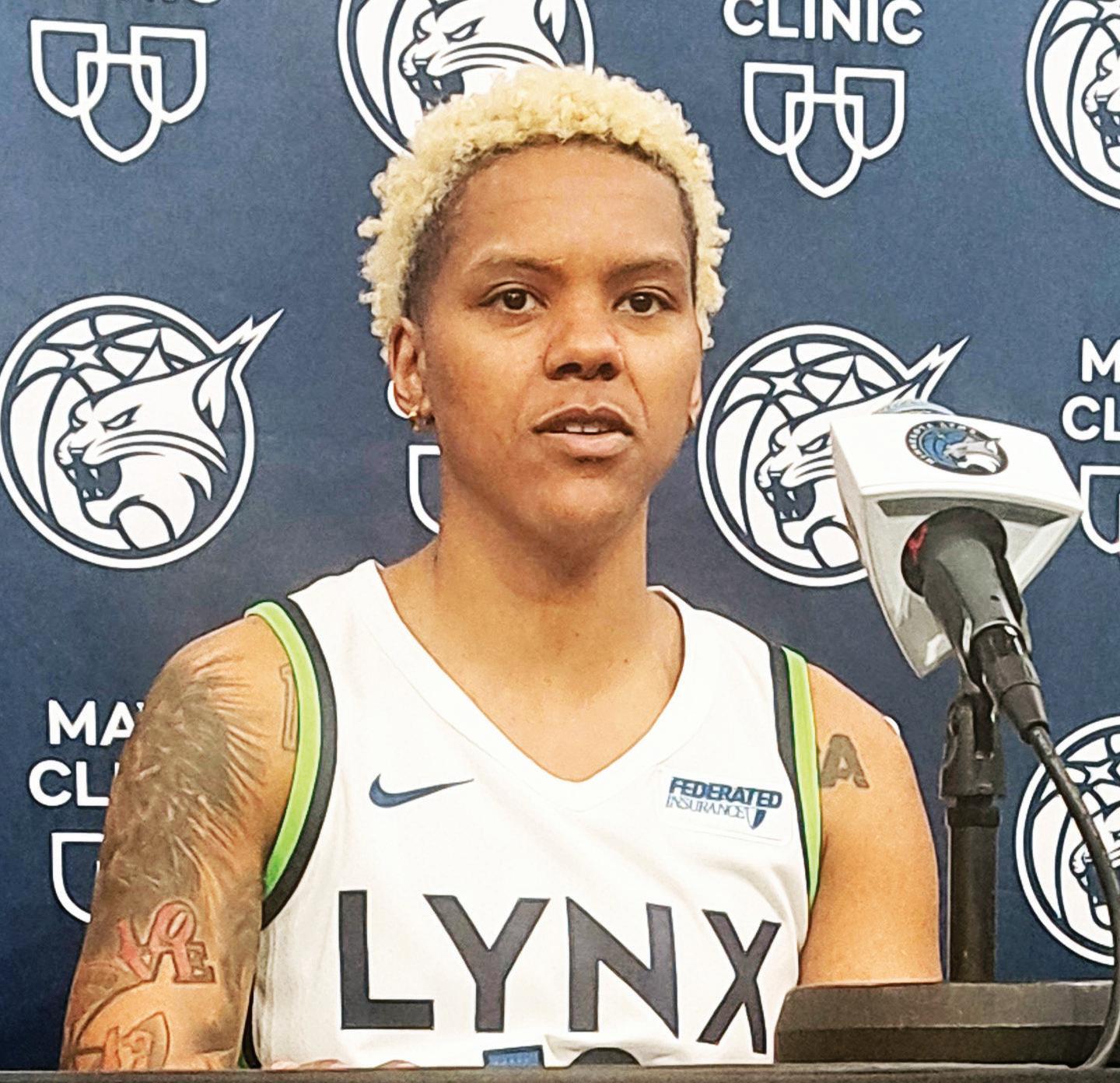
School, where the daughter broke the mother’s singlegame scoring record with 42 points, two more than her mother’s 40 in her junior season. She matriculated to the University of South Florida, where Williams went from being a solid role player off the bench to three-time AllAmerican, three-time all-conference, and the only player in USF history to amass 2,000 points, 900 rebounds, and 300 assists in a career.
Originally drafted by Phoenix in the first round (8th overall) in 2016, Williams didn’t see much court time there. But Connecticut traded for her in mid-season and she played for the Sun (2016-19). Curt Miller, now at Los Angeles, was the Sun coach and GM who traded for Williams.
“That’s why I give a shoutout to that man,” said Williams as she pointed across toward Miller during pregame warmups before the SparksLynx contest earlier this month. We chatted after she completed her shooting routine. Miller gave Williams “my real first opportunity,” she added.
Williams also played for Atlanta (2020-21), then back at Connecticut (2022) before her only season in Chicago (2023).
Since joining the Lynx, Williams hasn’t totally abandoned her scoring instincts. Against the Sparks that night we talked, the guard posted her first

t was my second time ever in Birmingham, Alabama as I covered the MLB game at Rickwood Field last Thursday to honor nearly 60 Negro Leagues players still alive. However, little was said about Rising, the neighborhood where Rickwood is located.
“Nobody wants to hear our story,” said Jeffrey (his last name withheld by request).
Rising-West Princeton, or Rising for short, is located on Birmingham’s West End, a predominantly Black neighborhood sandwiched between white neighborhoods to the north and south in a fivesix block radius. Rickwood, America’s oldest ballpark (114 years), is one of several neighborhood landmarks.
Jeffrey was born in Rising nearly 70 years ago. As a youngster growing up, he was Birmingham’s minor league team batboy and ballboy. He and a young Reggie Jackson were the only Blacks on the team.
“It was hard on him,” Jeffrey recalled of Jackson, a future Hall of
By Charles Hallman Sports Columnist
erald Young in a few days officially starts his retirement. The longest tenured Black athletic director in the MIAC will step down on July 1 from his dual roles as athletic administrator, professor and department chair, a total of 32 years at Carleton College on July 1.
In a recent “exit” phone interview, Young told the MSR, “I’m getting out while I have great health. I’m 63 now.”
Young leaves CC with a ton of accomplishments under his watch: 35 MIAC Coach of the Year honors, 32 league regular season titles, 10 playoff crowns, and 32 NCAA championships trips.
After 17 years as an assistant football coach, 10 years as an assistant softball coach and a track and field assistant coach before assuming the AD position in 2010, Young has served on the NCAA Division Three Management Council, the MIAC Budget Committee, and was an active leader in the Minority Opportunities Athletic Association.
In May, Young was granted the MIAC Distinguished Service Award, only the school’s second such honoree since 2010.
“It’s been a good run,” said Young.
The world of college sport, even at the Division Three level, has seen numerous changes since Young became Carleton’s AD. “College sport is really at a critical crossroads,” he pointed out. “It’s becoming pay-for-play minor league stuff that’s never been the reason I think a lot of people got
into this profession.”
NIL at present hasn’t been a major issue either, since Division Three schools do not have athletic scholarships. “I’ve seen no effect whatsoever,” reports Young, “but I think that eventually it’s coming to [DIII]. I don’t know where.” But student-athlete mental health remains a high priority in college sports, he added.
“We really think that there are some steps in general to try to make it better for our student athletes in that aspect of it,” said Young Over the years, Young has been a strong advocate for more Black athlete directors at all levels. With his retirement, Macalester’s Donnie Brooks now is the conference’s only Black athlete director.
“I had hoped that we’d make more strides, not so much in the athletic director’s chair but
in athletic administration overall. I don’t think it’s for lack of people trying.
“When I started as an AD in Division Three, there were maybe a handful of us,” said Young. “When I was at the [NCAA] convention in January, there were about 40 of us in the room.
“It’s been a good run.”
“My number-one goal was to raise the bar for us to have more, not just in Minnesota but nationally,” continued Young. “I wanted it to grow, and I think it is really a great thing to see that.”
Said MIAC Associate Commissioner BJ Pickard, “We are going to miss Gerald. He
has been so impactful for our conference on so many fronts, more importantly being a really good, really smart, really thoughtful person who really cares about small college athletics and athletes.”
Young said that he has passed “the pushing for more diversity” baton to Brooks: “It’s time for him to step up.” Heidi Jaynes was promoted from senior woman administrator to Carleton AD.
Although he is stepping down, Young said he won’t be totally away from the school where he has served for over three decades. “I am OK with being on speed dial” whenever he is needed for advice and counsel. “I’m still going to stay here in Minnesota.”
Charles Hallman welcomes reader comments at challman@ spokesman-recorder.com.

Famer who bluntly spoke about life in segregated Birmingham before last Thursday’s game.
“Our neighborhood wasn’t that big,” continued Jeffrey.
“Kids worked at the ballpark.
That’s how we made our little money in the summer.”
Rising was a middle-class Black neighborhood when Jeffrey grew up there: “We had brick homes. Everybody knew everybody.” However, the neighborhood these days is a shell of its former self. Jeffrey eventually moved north to Michigan, but returned to Birmingham and Rising in 2016 and discovered it had changed.
“The neighborhood is still a family,” said Jeffrey. “We still got some folks still [living there]. Some of the families just didn’t take care of the property.”
“We
have been working with Major League Baseball for a very, very long time to make this game possible.”
After announcing last summer the first regular season MLB game would be played at the old Negro Leagues ballpark, MLB invested $4.5 million in ballpark renovations; reportedly nearly $6 million was spent in total.
“We have been working with Major League Baseball for a very, very long time to make

this game possible,” said Chris Mosley, the neighborhood liaison for Birmingham City. Councilwoman Carol Clarke, a Black woman who represents District 8, which includes Rising. “This is a truly beneficial opportunity that we will take advantage of.” For last week’s game, both MLB and the City of Birmingham made 26% of the approximate 8,300 seat tickets available to community or youth-based organizations in Birmingham at no cost. Also, more than 200 part-time employees were hired from the surrounding neighborhood and throughout Greater Birmingham to work all Rickwood events throughout last week—the game, a celebrity softball game, and a concert held outside the stadium. We

ast week the Boston Celtics, behind the outstanding play of Jaylen Brown, Jayson Tatum, Jrue Holiday, Derrick White, and Al Horford won their leagueleading 18th NBA championship defeating the Dallas Mavericks 4-1 in the best-of-seven series.
Rather than repeat the obvious details reported by other media outlets, this columnist feels that a history lesson is in order.
It’s no secret that the Celtics won championships in the 1950s, ‘60s. ‘70s and ‘80s. It’s also no secret that African Americans such as Bill Russell, Sam Jones, Thomas “Satch” Sanders, JoJo White, Paul Silas, Dennis Johnson, Nate “Tiny” Archibald, Cedric “Cornbread” Maxwell and Robert Parrish, to name a few, played a prominent role in their success during this period while much fanfare was given to white players that included Bob Cousy, Tommy Heinson, John Havlicek, Don Nelson, Dave Cowens, Kevin McHale, Bill Walton and Larry Bird
While Boston has a reputation as a city with racial overtones, the Celtics organization has made decisions involving African Americans that have had a profound impact on the NBA as it is today. Below are
those choices and accomplishments that changed the NBA:
The first Black player to be drafted
With the 14th pick in the 1950 NBA draft, the Celtics selected Charles Cooper, a 6’4” guard from Duquesne University, making him the first Black player to ever be drafted. Cooper, an All-American while in college, played four years for the Celtics before being traded to the Milwaukee Hawks and finishing his career with the Fort Wayne Pistons in 1956.
The first Black NBA superstar With the No. 2 pick in the 1956 draft, the Celtics drafted Russell after an outstanding career at the University of San Francisco. The 6’9” center, an outstanding scorer, rebounder, shot blocker and leader, became the first Black superstar in a white-dominant NBA, leading Boston to 11 NBA championships in 13 seasons.
The first all-Black starting lineup
The Celtics were the first to start five Black players in the NBA during the 1964-65 season. When starting forward Tommy Heinson, who was white, injured his foot in December, head coach Red Auerbach had a decision to make before the team faced the St. Louis Hawks.
Rather than start sixth man John Havlicek, who was white, Auerbach inserted forward Willie Naulls, who along with guards Sam Jones and K.C. Jones, forward Thomas “Satch” Sanders, and center Russell formed the NBA’s first